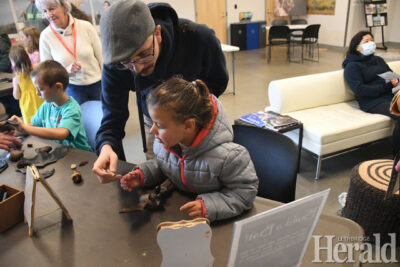Locals wing in to nature centre for Bats Discovery Day
By Justin Seward - Lethbridge Herald on October 28, 2022.
 Herald photo by Justin Seward
Cody Leis helps four-year-old Olivia build a bat during Bats Discovery Day at the Helen Schuler Nature Centre.
Herald photo by Justin Seward
Cody Leis helps four-year-old Olivia build a bat during Bats Discovery Day at the Helen Schuler Nature Centre.Helen Schuler Nature Centre was the site for their recent Bats! Discovery Day.
The day was in recognition of World Bat Week which celebrates all the things the mammal does and assists in dispelling some of those myths that are out there about the animal.
“We wanted to have a day where the community could come down to the Nature Centre, try some different activities out, play some different games,” said Jessica Deacon-Rogers, Nature Centre program co-ordinator. “We also have volunteers from the Alberta Community Bats program here today and they’re bat experts actually – both of them are wildlife biologists that study bats. So it’s a really neat opportunity for the public to actually talk to people that know bats and study bats for years and years in southern Alberta.”
Participants could participate in activities such as build-a-bat, a matching game to see what bats can eat, find out how bats are weighed, as well as colouring and videos with the Alberta Community Bats Program which highlights the importance of bats in the community, sound activity and how the animal uses it.
“I think people often don’t realize how important bats are in our community,” said Deacon-Rogers.
“They eat a lot of insects. So one bat can eat almost its body weight in insects in one night. So if you think about pest control from a person’s perspective, that’s a huge amount of insects; like mosquitos and moths and things that would be more of a pest in our community. So they have a huge role in our ecosystem in southern Alberta in helping to control insect populations.”
A common myth is that humans can get rabies from bats.
“They do carry rabies, but so do dogs and lots of other kinds of animals,” said Deacon-Rogers.
“So if you ever did have a bat that you found on the ground, it is important to make sure to handle them with things like leather gloves so you aren’t bit. But the percentage of bats that carry rabies is very low – much lower than actually in dogs.”
The southern Alberta bats all eat insects, she confirmed. Deacon-Rogers said people often think about vampire bats around Halloween or bats that suck your blood.
“And that is not the type of bat that we have here in southern Alberta,” she said. “So people don’t need to be worried about them wanting to attack you or anything. They’re out there looking for insects. At this time of year, people often don’t know what happens to bats during the winter. They are here in the summer; we see them out at dusk catching insects and things like that… so they are a species that does migrate or hibernate.”
Bat biologist Mike Kelly explained a significant threat to bats in the province in the white-nose syndrome. White-nose syndrome is a fungal disease in bats that has decreased the population.
“We haven’t detected white-nose syndrome here yet,” said Kelly.
“But it is on the border. We’ve found it in Saskatchewan and populations out east, where white-nose syndrome is well established (but it) has declined (bat populations) as much as 99 per cent in some cave systems. Some of those populations are coming back but it takes a really long time because bats are slow reproducing. They live long lives. A little brown myotis can live up to 40 years or more and they only have one offspring per year.”
There are four species of bats in southern Alberta including the big brown bat, the hoary bat, the little brown bat and the small-footed bat.
16-15


